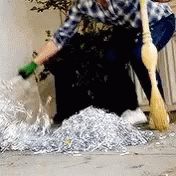Industry study is where you can stop reading. The industry in question has been lying to everyone about the impacts of climate change for over half a century.
When they say “we can use carbon capture to create permission to keep on extracting and burning more than we’re capturing” believe them.
Carbon capture, illustrated:

Not to say we shouldn’t try to pull CO2 from the atmosphere, but I just don’t see how we can do that without it also being permission to keep emitting at current levels.
If you look a the physics and engineering challenges of attempting to pull CO2 out of the atmosphere, you’ll very soon reach the conclusion that it’s better to stop CO2 emissions at the source, or to reduce activities that cause CO2 emissions.
The only people who would rather put pollution into the atmosphere, then spend vast amounts attempting to take it out again, are those whose profits come from selling the oil.
The technology is here and it is developing at a rapid pace. There are a lot of clever ways to remove CO2. Keep in mind “CDR” - carbon dioxide removal and “CCUS” - carbon capture, utilization & storage are two different approaches to reducing atmospheric CO2 concentrations. CDR includes soil carbon sequestration, bio-char, ocean alkalinity. CUS is storage of supercritical CO2 between the pore space of permeable rock.
That’s why industry people keep yelling about it, even though some very large scale attempts at it were already failures.
They’ll keep pushing the scam for the same reason we all have to use paper straws; misdirection.
There’s no reason to extend use of oil by 84 years. There are strong reasons to terminate its use as soon as we can.
Opinions such as this simply don’t understand that “oil and gas” isn’t just “fuel”.
There isn’t any component of modern life that wasn’t created with at least some level of a petroleum based product.
That “electric car” we rave about? Its tires are rubber. Its moving parts are lubricated. Its wires are sheathed and grounded by plastic. Its faux leather or nylon interior is petroleum based. Same thing if you ride a bike.
If we go into your house, Anything you own that has any amount of rubber, or plastic, or half a thousand other materials is petroleum based.
Getting rid of oil isn’t nearly as simple nor as quick a process as opinions like this seem to want.
Yes, oil needs to be phased out. But it’s a hell of a lot more complicated than hippies think.
You are right, but to be fair most things that are petroleum based are made with it because of economic reasons. Many things don’t need to be it’s just cheaper that they are. That’s because of a combination of factors. If tomorrow every oil field in the world disappeared we would see alternatives for almost everything almost instantly because there would be huge financial incentive for it and many of those things already exist, they just have to compete with a very established and subsidized raw material
For anyone wondering whether to click: yes, the article is very critical of this and gives a lot of space to experts who think that this is an absolutely terrible idea. I think the value here is in knowing what the oil industry tries to do and how they try to lie to justify their crimes.
Removed by mod
I am a geologist that specializes in site characterization for carbon storage reservoirs. Like with any large engineering project there are certain risks but CO2 leaks can be modeled and mitigated with responsible project planning. I can go in more detail if you are interested.
Removed by mod
I absolutely agree with you orphan wells pose a huge problem when it comes to methane leaks and water pollution. That said CO2 injection wells operate under an entirely different suite of regulatory requirements and involve vastly different stakeholders in the initial project planning phase. I am based in the United States so I can’t speak to the regulations other countries are developing. The US is behind on adequate regulations (Congress as usual dragging their feet) but right now CO2 injection wells follow the “Class VI” requirements set out by the EPA. Injection of CO2 must be below the groundwater table, below a proven confining rock layer (to prevent any CO2 from migrating anywhere near the surface) and be at least 800 meters below the surface to ensure CO2 is under enough pressure to remain stagnant. Before, during, and after injection these wells must have a suite of monitoring tests including 4D seismic, soil gas measurements, and in-situ pressure gauges. When the well is no longer active it is plugged and the operator is still liable for the project area for 50 years. By 50 years anything that could go wrong would have done so already, most geophysical models of CO2 leaks assure its storage for at least 100 years but I prefer 10,000 years to emphasize the storage assurance.
Additionally a smart carbon capture project would utilize CO2 mineralization processes that capture the CO2 in the crystal of a mineral (like calcite). This removes the problem supercritical CO2 may pose. This process is geology dependent and works well in basaltic rocks, the Climeworks mammoth plant in Iceland is an example of this.



